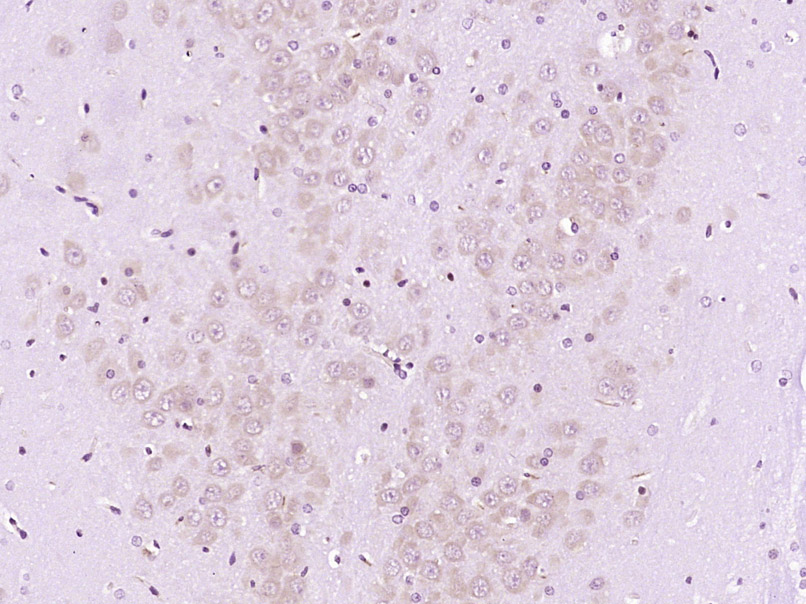
Rabbit Anti-WISP3 antibody
CCN 6; CCN family member 6; CCN6; CYR61; LIBC; Lost in inflammatory breast cancer tumor suppressor protein; MGC125987; MGC125988; MGC125989; OTTHUMP00000040421; PPAC; PPD; UNQ462/PRO790/PRO956; WISP 3; WISP-3; WISP3; WISP3_HUMAN; WNT 1 inducible signaling
View History [Clear]
Details
Product Name WISP3 Chinese Name Wnt1信号通路蛋白3抗体 Alias CCN 6; CCN family member 6; CCN6; CYR61; LIBC; Lost in inflammatory breast cancer tumor suppressor protein; MGC125987; MGC125988; MGC125989; OTTHUMP00000040421; PPAC; PPD; UNQ462/PRO790/PRO956; WISP 3; WISP-3; WISP3; WISP3_HUMAN; WNT 1 inducible signaling pathway protein 3; Wnt 1 signaling pathway protein 3; WNT1 inducible signaling pathway protein 3; WNT1 inducible signaling pathway protein 3 precursor; WNT1-inducible-signaling pathway protein 3. Research Area Tumour Cell biology Developmental biology Signal transduction Stem cells Immunogen Species Rabbit Clonality Polyclonal React Species Rat, (predicted: Human, Mouse, Dog, Horse, Rabbit, Sheep, Monkey, ) Applications WB=1:500-2000 ELISA=1:5000-10000 IHC-P=1:100-500 IHC-F=1:100-500 ICC=1:100-500 IF=1:100-500 (Paraffin sections need antigen repair)
not yet tested in other applications.
optimal dilutions/concentrations should be determined by the end user.Theoretical molecular weight 37kDa Cellular localization Secretory protein Form Liquid Concentration 1mg/ml immunogen KLH conjugated synthetic peptide derived from human WISP3: 221-320/354 Lsotype IgG Purification affinity purified by Protein A Buffer Solution 0.01M TBS(pH7.4) with 1% BSA, 0.03% Proclin300 and 50% Glycerol. Storage Shipped at 4℃. Store at -20 °C for one year. Avoid repeated freeze/thaw cycles. Attention This product as supplied is intended for research use only, not for use in human, therapeutic or diagnostic applications. PubMed PubMed Product Detail Wnt-induced secreted protein (WISP)-1, WISP-2 and WISP-3 are members of the CCN family of growth factors, which include connective tissue growth factor (CTGF) and Cyr61. WISP-1, WISP-2 and WISP-3 share significant sequence similarity, including four conserved cysteine-rich domains, and they are believed to function as dimers in their active forms. WISP-1 expression is observed in various tissues including adult heart, kidney and spleen, while WISP-2 expression predominates in skeletal muscle, colon and ovary. Both WISP-1 and WISP-2 are upregulated in cells transformed with the proto-oncogene Wnt-1, and they are also more highly expressed in human colon tumors, suggesting that these proteins may participate in tumor development. WISP-3 is involved in normal post-natal skeletal growth, and it is also implicated in the development of the autosomal recessive skeletal disorder progressive pseudorheumatoid dysplasia, which affects cartilage homeostasis by disrupting the growth of chondrocyte and normal cell columnar organization.
Function:
Appears to be required for normal postnatal skeletal growth and cartilage homeostasis.
Subcellular Location:
Secreted.
Tissue Specificity:
Predominant expression in adult kidney and testis and fetal kidney. Weaker expression found in placenta, ovary, prostate and small intestine. Also expressed in skeletally-derived cells such as synoviocytes and articular cartilage chondrocytes.
DISEASE:
Defects in WISP3 are the cause of progressive pseudorheumatoid arthropathy of childhood (PPAC) [MIM:208230]. PPAC is an autosomal recessive disorder characterized by stiffness and swelling of joints, motor weakness and joint contractures. Signs and symptoms of the disease develop typically between three and eight years of age. This progressive disease is a primary disorder of articular cartilage with continued cartilage loss and destructive bone changes with aging.
Similarity:
Belongs to the CCN family.
Contains 1 CTCK (C-terminal cystine knot-like) domain.
Contains 1 IGFBP N-terminal domain.
Contains 1 TSP type-1 domain.
SWISS:
O95389
Gene ID:
8838
Database links:Entrez Gene: 8838 Human
Entrez Gene: 327743 Mouse
Omim: 603400 Human
SwissProt: O95389 Human
SwissProt: D3Z5L9 Mouse
Unigene: 558428 Human
Unigene: 208111 Mouse
Unigene: 141375 Rat
Product Picture
Bought notes(bought amounts latest0)
No one bought this product
User Comment(Total0User Comment Num)
- No comment



 +86 571 56623320
+86 571 56623320
 +86 18668110335
+86 18668110335

